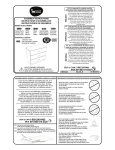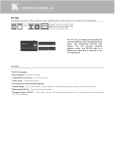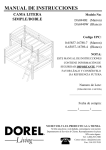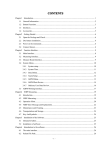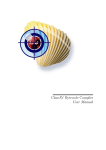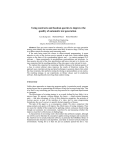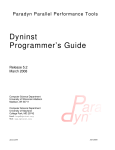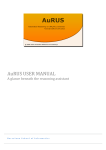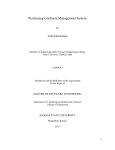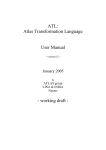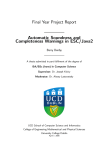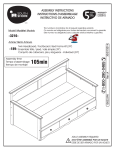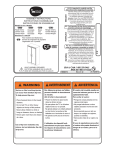Download UML2Alloy Reference Manual - Computer Science
Transcript
DRAFT (Updated 12-Aug-2007)
UML2Alloy Reference Manual
Version: 0.26
Date: Monday 10th September, 2007
Kyriakos Anastasakis
The University of Birmingham
School of Computer Science
Contents
List Of Figures . . . . . . . . . . . . . . . . . . . . . . . . . . .
1 Introduction
1.1
Minimum Requirements . . . . . . . . . . . . . . . . . . .
2 Translating UML
iii
1
1
2
2.1
Classes, Subclasses and Types . . . . . . . . . . . . . . . .
2
2.2
Enumerations . . . . . . . . . . . . . . . . . . . . . . . . .
2
2.3
Associations . . . . . . . . . . . . . . . . . . . . . . . . . .
3
2.4
Class Attributes . . . . . . . . . . . . . . . . . . . . . . .
3
2.5
Class Methods . . . . . . . . . . . . . . . . . . . . . . . .
4
3 Translating OCL
5
3.1
Invariants . . . . . . . . . . . . . . . . . . . . . . . . . . .
5
3.2
Operations . . . . . . . . . . . . . . . . . . . . . . . . . .
6
3.3
OperationCallExps . . . . . . . . . . . . . . . . . . . . . .
6
3.3.1
Implies . . . . . . . . . . . . . . . . . . . . . . . .
6
3.3.2
And . . . . . . . . . . . . . . . . . . . . . . . . . .
6
3.3.3
Dot . . . . . . . . . . . . . . . . . . . . . . . . . .
6
3.4
If . . . . . . . . . . . . . . . . . . . . . . . . . . . . . . . .
6
3.5
Iterator Expressions . . . . . . . . . . . . . . . . . . . . .
7
3.6
notEmpty . . . . . . . . . . . . . . . . . . . . . . . . . . .
7
3.7
Not . . . . . . . . . . . . . . . . . . . . . . . . . . . . . . .
7
3.8
Variable Expressions . . . . . . . . . . . . . . . . . . . . .
7
3.9
Integer Expressions . . . . . . . . . . . . . . . . . . . . . .
7
4 UML2Alloy: Usage Manual
8
4.1
Installation . . . . . . . . . . . . . . . . . . . . . . . . . .
8
4.2
Using UML2Alloy . . . . . . . . . . . . . . . . . . . . . .
8
4.2.1
Step 1 . . . . . . . . . . . . . . . . . . . . . . . . .
8
4.2.2
Step 2 . . . . . . . . . . . . . . . . . . . . . . . . .
8
4.2.3
Step 3 . . . . . . . . . . . . . . . . . . . . . . . . .
9
5 Examples
10
5.1
Two Unidirectional vs One Bidirectional Associations . .
10
5.2
Using UML2Alloy in a model with integer expressions . .
12
5.2.1
The UML model . . . . . . . . . . . . . . . . . . .
12
5.2.2
Transformation . . . . . . . . . . . . . . . . . . . .
14
5.2.3
Results . . . . . . . . . . . . . . . . . . . . . . . .
14
A XMI Compatibility
19
B UML2Alloy Manual Document Changelog
20
C UML2Alloy Application Changelog
21
References . . . . . . . . . . . . . . . . . . . . . . . . . . . . . .
22
ii
List of Figures
4.1
First Screen of UML2Alloy . . . . . . . . . . . . . . . . .
8
4.2
Second Screen of UML2Alloy . . . . . . . . . . . . . . . .
9
4.3
Final Screen of UML2Alloy . . . . . . . . . . . . . . . . .
9
5.1
Example UML model of two classes connected with two
unidirectional and one bidirectional association . . . . . .
10
5.2
Exporting model to XMI using ArgoUML . . . . . . . . .
11
5.3
Selecting the mapping . . . . . . . . . . . . . . . . . . . .
11
5.4
Selecting the statement we want to check . . . . . . . . .
12
5.5
Counterexample
. . . . . . . . . . . . . . . . . . . . . . .
13
5.6
UML model of example . . . . . . . . . . . . . . . . . . .
13
5.7
Screenshot of the second step of the transformation process 14
5.8
Providing the scope
. . . . . . . . . . . . . . . . . . . . .
15
5.9
Alloy model of example with integer expressions . . . . .
16
5.10 A counterexample to the assertion . . . . . . . . . . . . .
17
iii
1
Introduction
This document is the user manual of UML2Alloy version 0.26 alpha [2]. The transformation rules are
based on Alloy version 4 and UML version 2.0.
UML2Alloy is the outcome of research which attempts to formalise UML using Alloy [4]. UML2Alloy
translates UML Class Diagrams enriched with OCL constraints to Alloy. Alloy models can be automatically analysed using the Alloy Analyzer [1]. The current version of UML2Alloy performs the translation
to the Alloy language and creates a text file with the Alloy model. The user needs to use the Alloy
Analyzer to open the text file and perform the analysis using Alloy Analyzer. In the future we endeavour
to use Alloy Analyzer as a library to incorporate its functionality in UML2Alloy.
The Alloy Analyzer works by translating the model into a boolean expression, which is analysed by SAT
solvers embedded within the Alloy Analyzer. A user-specified scope on the model elements bounds the
domain, making it possible to create finite boolean formulas for the evaluation by SAT solvers. The
Alloy Analyzer offers two analysis methods. One is simulation and the other is assertion checking.
Simulation produces a random instance of the model that conforms to the constraints. The absence of an
instance implies that most probably the model is inconsistent. It is possible from within the Analyser, to
narrow down the statements, which produce the inconsistent model. This functionality is called UnSat
Core.
Assertion checking, checks whether an assertion, which is a statement which should follow from the
specification, is satisfied by the model. If it is not, a counterexample is presented to the user. A
counterexample is an instance of the model, which violates the assertion.
This manual contains some information for both Alloy and the Alloy Analyzer for people familiar with
UML but unfamiliar with Alloy. For more information on the Alloy Analyzer and the Alloy language,
the reader is refereed to [4] and [1].
If the reader is interested in the transformation rules and the restrictions on the translation, the reader
is referenced to Chapters 2 and 3. If the reader wants to learn details on how to use UML2Alloy, (s)he
is referenced to Chapter 4. Finally Chapter 5 presents a number of simple examples to demonstrate how
UML2Alloy can be used.
1.1
Minimum Requirements
UML2Alloy requires Sun Java 1.5
2
Translating UML
This section provides a brief informal overview of the transformation rules from UML to Alloy. The
rules are implemented in UML2Alloy. This section also mentions any restrictions that might exist.
2.1
Classes, Subclasses and Types
° Translates Classes to Signatures. If the class isAbstract it will be translated to an abstract Signature.
° Translates subclasses to subsignatures. The default subclassing semantics is {incomplete, disjoint} [7, p. 72]
° Enumerators are translated to abstract Signatures and Enumerator literals are translated to subsignatures with one element (Singletons). For more information see Section 2.2.
° Custom data types. We translate all Classes with the “DataType” stereotype to Signatures. In
principle Custom data types are not treated any different than any other Class.
Restrictions
X No primitive data types (as defined in the UML standard) are currently supported by the implementation. (Since UML2Alloy 0.3, rudimentary support for integer expressions has been introduced).
X Multiple packages are not supported. Translation of the classes of one package at a time takes
place.
X Multiple inheritance is not allowed (the transformation rules have been defined, but not implemented in the tool).
X Only subclasses with {incomplete, disjoint} semantics are allowed. Again the rules for the rest of
the cases have been defined, but we haven’t implemented them.
X Subclasses can not redefine attributes, operations. Thus attribute and operation names can not
have the same name as the attribute and operation names of the superclasses.
X The NameSpace to which Classes can belong to is not restricted by the UML specification. Thus
a Class can belong to the NameSpace of another Class (inner Classes). Our rules only support
Classes which belong to the NameSpace of a Package.
2.2
Enumerations
° Enumerations are translated to abstract Signatures.
° Enumeration literals are translated to Subsignatures, which extend the abstract Signature of the
Enumeration. Since each enumeration literal represents only one value, it is declared as a Signature
represented by one atom in Alloy.
Restrictions
2 Translating UML
3
X Enumerations have to be defined in the UML class diagram as Classes with an “Enumeration”
stereotype. Enumeration literals have to be defined as attributes of the Class. Attributes have to
be of void type.
2.3
Associations
Please note that in this section the term Association End is used, to reference the ends of an association.
Even though this term is used in the UML specification (for example see [7, p. 14] or [7, p. 40]), the
UML metamodel reffers to Association Ends as Properties [7, p. 29].
° All association ends have to have names. Role names have to be unique. (Since UML2Alloy 0.3
this is not a requirements). If an Association End does not have a name, it will be assigned the
name of the
° Unidirectional Associations: The navigable Association End appears as a field in the Signature to
which the original Class the association belonged to, was translated.
° Bidirectional Associations: Association Ends appear as fields in both the Signatures that participate in the relation. An additional fact is added to the model, to denote that the relations are
symmetric.
° Multiplicities: Depending on the multiplicity of the Association Ends, the necessary multiplicity
facts will be added to the model.
Restrictions
X Association End names have to be unique throughout the model (i.e. all Association Ends have to
have unique names, in contrast with the UML specification, which allows two separate Association
Ends to have the same name, as long as they belong to different Classes).
X Association End annotations are not supported (e.g. subsets, ordered etc.).
X Only binary associations are supported in the current version of the implementation.
X Custom multiplicities are not currently supported by the implementation. Only the predefined (1,
0..1, 1..* and 0..*) multiplicities are supported.
X The UML specification allows for unspecified navigability [7, p. 41]. Such cases are not supported.
X The UML specification allows for binary associations with both ends non navigable. Again such
cases are not supported.
X This version of UML2Alloy has not implemented our rules for aggregation and composition. Associations with composition or aggregation have to be refactored using the method defined by Gogolla
and Richters [3].
X Association Classes are not currently supported.
2.4
Class Attributes
° Class attributes are translated to Signature fields.
Restrictions
X Attributes have to be of a specific type (i.e. not void ). This restriction does not apply for
enumeration literals, see Section 2.2.
X Only attributes with multiplicity of 1 are supported.
2 Translating UML
2.5
Class Methods
° Class methods are translated to Alloy predicates. For more information see Section 3.2.
Restrictions
X Class method can not return any type, other than Boolean or Void.
X Operations in UML may raise exceptions. UML2Alloy does not deal with such cases.
4
3
Translating OCL
This section presents the details on the translation of OCL statements (invariants and pre and postconditions) to Alloy.
IMPORTANT NOTE: NO shorthand notation is supported for OCL expressions. For example:
Use: collection → forAll(v:Type | boolean-expression-with-v)
Do NOT use: collection → forAll(v | boolean-expression-with-v)
Do NOT use: collection → forAll(boolean-expression)
Use: self.attribute
Do NOT use: attribute
OCL expressions which reference the Boolean values true or false directly are not supported. For example
an expression like:
if condition then
expression
else
false
endif
is not currently supported. Instead an expression which always evaluates to false could be used, in the
‘else’ branch of the above statement.
3.1
Invariants
Please NOTE: The UML standard specifies that invariants are implicitly qualified over all
of the instances of the context [5, A.3.1.5]. So for example an invariant:
context C1
inv test: self.attribute = value
is implicitly transformed to:
context C1
C1.allInstances → forAll(v1:C1 | v1.attribute = value)
UML2Alloy currently supports only the second expanded form (i.e. with the explicit quantification, using allInstances and forAll), NOT the first form. Support for the first form
will be provided in the future.
° Class invariants are generally translated to Alloy facts. They can also be translated to Assertions.
This is defined during the transformation process. For more information please see the examples
in Section 4.2.2.
° Each invariant is translated to a predicate and then a fact statement, which references the predicate
is added.
Restrictions
3 Translating OCL
6
X Only Class invariants defined in the namespace of a Class are supported (i.e. Class invariants).
X Invariants have to have a name.
3.2
Operations
The effects of Operations is defined using OCL pre and post conditions.
NOTE: The current version of the implementation only supports postconditions.
° Operations are transformed to Alloy Predicates. Operations are defined in the context of a Class.
Because in Alloy Predicates belong to the NameSpace of the model, an instance of the Signature on
which the specification of the Predicate is applied, is passed as a parameter to the Class. Therefore
all references to the self keyword used in OCL are transformed to the parameter passed in the
Predicate. For a detailed example please see Section[].
Restrictions
X The current implementation supports one OCL expression as specification to the Operation.
X Pre and Post conditions have to have a name.
X Operations can be of either Boolean or Void type.
X Currently Operations can not have any parameters.
3.3
OperationCallExps
In OCL a large number of expressions are OperationCall expressions. For example equality, implies, and,
or, etc. expressions, are considered to be OperationCall expressions. The following shows how those
OperationCall expressions are translated to Alloy.
3.3.1
Implies
° Implies OperationCalls are directly translated to an Alloy implies formula (ImplicationFormula).
3.3.2
And
° An OCL and OperationCall is translated to an Alloy binary formula (BinaryFormula) with a AND
Logical operator.
3.3.3
Dot
Dot OperationCall expressions in OCL, are navigation expressions, which use the navigation dot (.).
° An OCL Dot OperationCall is translated to an Alloy binary expression BinaryExpr with a JOIN DOT
binary expression Operation.
3.4
If
° An OCL If Expression is transformed to an Alloy implies formula (ImplicationFormula). In Alloy
an ImplicationFormula can have an else clause, which is what the OCL else clause is translated
to.
3 Translating OCL
3.5
7
Iterator Expressions
° An OCL Iterator Expression is transformed to an Alloy Quantified Formula.
Restrictions
X Currently only the forAll and exists Iterator Expressions are supported.
X Can only translate Iterator Expressions of the form: Class.allInstances() → forAll or Class.allInstances()
→ exists.
X Do not currently support nested Iterator Expressions.
3.6
notEmpty
° An OCL notEmpty expression is transformed to an Alloy ElemIntFormula. In particular it is
translated to an Alloy Formula which enforces the size of the Expression to be greater than zero.
For an example please refer to Chapter 5.
Restrictions
X The notEmpty operator has to be applied to a simple navigation expressions such as: Person.allInstances rightarrow exists(p:Person | p.wife → notEmpty ). Currently UML2Alloy does
not support the application of notEmpty to more complicated expressions, such as Iterator Expressions.
3.7
Not
° OCL not expressions (expressions with a negation) are directly transformed to Alloy Negation
Formulas NegFormula.
3.8
Variable Expressions
° OCL Variable Expressions (for example in the expression ‘self.name’, self is a Variable Expression),
are transformed to Alloy Variable Expressions (VariableExpr ).
3.9
Integer Expressions
° UML Class attributes of type integer are transformed to fields of type Int.
° OCL integer OperationCall expressions that match the pattern expression IntCompOp LiteralInteger, where expression is an expression, IntCompOp is an integer comparison operation (i.e. =,
<, >, >=, <=) and a LiteralInteger is an expression that denotes to an integer value (i.e. -3,0,1,
etc.), are transformed to Alloy ElemIntFormulas.
° OCL LiteralInteger s [6, p.60] are transformed to Alloy LiteralIntExpr s.
Restrictions
X Currently (version 0.3) do not support operations (i.e. addition, subtraction, multiplication, division) over integer values.
X Currently (version 0.3) only support OCL expressions that follow the pattern: expression IntCompOp LiteralInteger, where expression is an expression, IntCompOp is an integer comparison
operation (i.e. =, <, >, >=, <=) and a LiteralInteger is an expression that denotes to an integer
value (i.e. -3,0,1, etc.).
4
UML2Alloy: Usage Manual
This chapter is a brief guide on how to use UML2Alloy. It is suggested that ArgoUML version 0.19.5
is used to develop any models. The reason for this is that ArgoUML provides syntax checking for OCL
statements. Please note that apparently some versions (greater than 0.19.5) have a bug in the OCL
syntax checker.
4.1
Installation
Unpack the compressed file of the distribution to a directory. Depending on the platform edit the
run windows.bat or run linux.sh files and make the necessary changes to the path variables.
The program can be started by executing the run windows or run linux files respectively.
4.2
4.2.1
Using UML2Alloy
Step 1
Figure 4.1 depicts the first screen that prompts the user to select the path to the XMI file of the UML
model. For a table of the XMI files currently supported by UML2Alloy, please refer to Appendix A. The
user then needs to select the path to the Alloy file (text file with an als extension) that will be generated
if the transformation is successful.
The user then needs to click on Parse. This starts the parsing method. Messages on the progress appear
on the console. The next screen that will be presented to the user is depicted in Figure 4.2.
4.2.2
Step 2
In this screen the user is presented with all the Invariants and Operations of the UML models. The
first column depicts the Operation or Invariant name. The second column shows if the statement is an
Invariant or Operation in the original UML model. Finally the third column has a drop down menu,
which allows the user to select to what kind of Alloy statement the original UML statement will be
transformed.
The drop down menu with the selections is populated with the following rules. An OCL Invariant can
be translated to an Invariant (Fact in Alloy terms), Assertion or Simulation statement. An Operation
Figure 4.1: First Screen of UML2Alloy
4 UML2Alloy: Usage Manual
9
Figure 4.2: Second Screen of UML2Alloy
Figure 4.3: Final Screen of UML2Alloy
can be translated to a Predicate, Simulation or Invariant. An Operation with an OCL statement, which
uses the ‘self ’ keyword, can only be transformed to a Predicate.
4.2.3
Step 3
The last step towards the translation of UML to Alloy, requires the user to specify the Scope. Figure 4.3
depicts a screenshot of this last step. The user can specify the default scope, which is the scope that
will be applied to all model elements. This can be overridden for specific model elements if a value other
than -1 exists in the scope box of a specific model element. By checking the checkbox of the last column
the user can enforce that a model element will have instances in the model. For a concrete example on
the usage of this function, please refer to the examples in Chapter 5.
5
Examples
This chapter presents a number of simple examples to demonstrate the usage of UML2Alloy.
5.1
Two Unidirectional vs One Bidirectional Associations
In this example we want to assert if two unidirectional associations between two classes have the same
meaning as one bidirectional association. To do so, we generate the model depicted in Figure 5.1. The
model was developed using ArgoUML version 0.19.5.
The model does not have any constraints. We want to assert that the two unidirectional associations
between Class1 and Class2 have the same effect on the model as the bidirectional association between
Class3 and Class4. The assertion we use is stated in OCL:
-- We call this statement ‘areSame’
context Class1
inv areSame : Class1 . allInstances() -> forAll (
cl1: Class1 | cl1 . c2 . c1 = cl1 )
This assertion states that for each Class1, if we navigate to Class2 and come back we will end up in the
same object as where we started.
In ArgoUML we define this assertion as an Invariant and when we use UML2Alloy in Step 2, we define
that we want to translate it as an assertion, i.e. a statement to check.
Similarly we formulate the following OCL statement to reason about the association between Class3 and
Class4.
-- We call this statement ‘bidirectional’
context Class3
inv bidirectiional : Class3 . allInstances -> forAll (
cl3 : Class3 | cl3 . c4 . c3 = cl3 )
We now export the model to XMI format from within ArgoUML. Figure 5.2 depicts a screenshot that
shows how to achieve that in ArgoUML.
Next we invoke UML2Alloy. In the first step of the transformation process we select the path to the
XMI file and the Alloy file we want to create. In the next step we select what each OCL statement maps
Class1
Class2
+c2
+c1
Class4
Class3
+c3
+c4
Figure 5.1: Example UML model of two classes connected with two unidirectional and one bidirectional
association
5 Examples
11
Figure 5.2: Exporting model to XMI using ArgoUML
Figure 5.3: Selecting the mapping
to in Alloy. This step is depicted in Figure 5.3. The areSame and bidirectional are the two invariants
we specified in ArgoUML. By default the statements specified as invariants in the original UML model
are translated to invariants in Alloy (facts, according to the Alloy terminology). We want to check if
these statements are satisfied. They therefore need to be transformed to assertions, not invariants. We
specify that by selecting in the drop down menus that the original OCL invariants are transformed to
assertions (indicated by the red arrows in Figure 5.3). We then click on the proceed button.
Finally in the last step, we specify a default scope of 3. We do not need to change any other parameters
in the last screen. The transformation process has finished without an error and the Alloy file has been
generated in the path we specified in the first step.
We now need to invoke the Alloy Analyzer to conduct the analysis. On the main Alloy Analyzer window,
we Open the Alloy file generated by UML2Alloy. We first have to Build the file. Then we need to select
from the drop down menu (indicated by the red arrow in Figure 5.4) the statement we want to simulate
or check. In this case our model has only two assertions, areSame and bidirectional.
We first select from the drop down menu the ‘areSame’ assertion and press on Execute. The Alloy
Analyzer produces a counterexample. This is an instance of the model that violates the assertion. This
instance is depicted in Figure 5.5.
From a closer examination of the instance we can see that there is a class, Class1 0 related to Class2 0,
5 Examples
12
Figure 5.4: Selecting the statement we want to check
which in turn is related to Class1 1. The assertion therefore fails, because navigating from a class to
another class and back, we end up with different class.
Currently the results of the analysis are represented using the Alloy Analyzer representation form (for
example as a Tree, as shown in Figure 5.5). In the future we plan to represent the results of the analysis
in terms of UML (i.e. object diagrams).
Checking the bidirectional assertion does not provide any counterexamples.
For more information on the Alloy Analyzer, please consult the Alloy website [1].
5.2
Using UML2Alloy in a model with integer expressions
This section presents a simple example, where a UML model with integer expressions is transformed to
Alloy.
5.2.1
The UML model
Figure 5.6 depicts a simple UML model. There two classes. A Person class and an Adult class, which
extends the Person class. The Person class has an attribute age of type Integer. An Adult can marry
another Adult.
There are some OCL constraints (related to integer values) attached to the model. The constraints of
the Person class are:
context Person
inv ageInv :
Person . allInstances() -> forAll (
p : Person | p . age > 0 )
The constraints of the Adult class are:
context Adult
inv adultInv :
Adult.allInstances ->forAll(
ad:Adult | ad . age >= 18 )
We need to check that in such a model a Person over 18 can only marry only another Person whose age
is over 18. This assertion can be formulated in OCL:
context Adult
inv assertion :
Adult . allInstances -> forAll (
5 Examples
13
Figure 5.5: Counterexample
Figure 5.6: UML model of example
5 Examples
14
Figure 5.7: Screenshot of the second step of the transformation process
ad : Adult | ad . marry . age >18 )
We now export this model from our UML modelling environment to XMI format and use UML2Alloy
to transform it to Alloy.
5.2.2
Transformation
In the first step of the transformation process we provide the path to the XMI file that contains the
UML model we presented in the previous section. We also specify the path of the Alloy file that will be
created.
In the second step of the transformation process we specify how invariants and operations of the UML
model map in Alloy. Figure 5.7 presents a screenshot. This shows that the ageInv and adultInv will be
transformed into Invariants (i.e. Facts in Alloy), while the assertion statement, will be transformed to
an assertion in Alloy. The next step in the transformation process is to specify the scopes.
As depicted in Figure 5.8, when defining the scope we now have another option, the ‘Integer Values
Range’, which is a drop down menu. Like all elements in Alloy, we need to specify a scope for integer
expressions. The user can select from the drop down menu the range of integer expressions for which
the model will be probed for a solution or a counterexample. In this case we have selected a range of
-32,31. So the largest negative integer in the model is -32, while the largest positive integer is 31.
The scope of integer values can be chosen according to the biggest positive/negative value we expect integers expressions to have to in the model. For example in our example we care about integer expressions
of scope 18 and over. This is why we chose a scope of -32,31 for this example.
Figure 5.8 also shows that we have enforced that there will be instances of Persons and Adults in the
model. We have also specified a default scope of 4, but defined a specific scope of 8 Persons.
5.2.3
Results
The Alloy model that was produced by UML2Alloy is depicted in Figure 5.9. Executing this Alloy model
provides a counterexample. The counterexample is depicted in Figure 5.10.
5 Examples
15
Figure 5.8: Providing the scope
The counterexample shows an Adult, Adult0 married to an Adult (Adult1 ), whose age is exactly 18 years
old. This counterexample is produced because according to our OCL invariant an Adult is someone who
is 18 years old or older (someone 18 years old is considered to be an Adult), while our assertion checks
for people over the age of 18.
More specifically the assertion asserts that all Adults (i.e. People 18 years or older) will marry another
Adult, whose age is over 18 years old. This obviously produces a counterexample.
This small UML example was used as a simple example to show how integer expressions in OCL can
be transformed in Alloy. The Alloy counterexample also showed that the Adult, Adult1 married Adult0
and Adult0 is married to Adult1 (Exercise: In this counterexample Adult0 is married to Adult1 and
Adult1 is married to Adult0. Is this always the case? Can an Adult1 be married to Adult2, while Adult2
is married to a third person, Adult3 ?).
5 Examples
16
module untitledModel
some sig Person{
age : one Int}
some sig Adult extends Person{
marry : lone Adult}
fact {My11To01[marry ,Adult ,Adult]}
pred My11To01(r:univ -> univ,
t: set univ, u: set univ){
all x:t|lone y:u|x.r=y
all y:u|one x:t| x.r=y }
fact
fact
{ ageInv[ ] }
{ adultInv[ ] }
pred adultInv ( ){
all ad : Adult | int ad . age >= 18
}
pred ageInv ( ){
all p : Person | int p . age > 0
}
assert assertion {
all ad : Adult | int ad . marry . age > 18
}
check assertion for 4 but 8 Person, 6 int
Figure 5.9: Alloy model of example with integer expressions
5 Examples
17
Figure 5.10: A counterexample to the assertion
Appendices
18
Appendix A
XMI Compatibility
We use the KMF XMI parser, so our parser is compatible with the XMI files the KMF parser can read.
We have tested UML2Alloy with a number of UML design CASE tools. Table A.1 shows the results of
our tests.
CASE TOOL
ArgoUML
ArgoUML
Poseidon For UML
MagicDraw
MagicDraw
VERSION
0.19
0.22
4.1 Community Edition
9.5 Community Edition
Any Version >= 10
SUCCESS
YES
YES
YES
YES
NO
Table A.1: CASE Tools Support
Appendix B
UML2Alloy Manual Document Changelog
This page provides an overview of the changes of this manual document (not UML2Alloy).
• Sections 3.9 and 5.2, which provide information on the support for Integer Expressions.
• Appendix C on the changelog of the UML2Alloy application.
Appendix C
UML2Alloy Application Changelog
• ** RELEASE OF VERSION 0.26 **
• Beta support for XMI 2.1 (XMI produced by the UML plugin of eclipse). It does not support
packages. Only supports classes defined in the namespace of the Model. Also only supports OCL
expressions defined as OpaqueExpressions.
• 09-Aug-2007: Beta support for integer types and expressions.
• 08-Aug-2007: If an attribute whose type is not supported is found, we raise a fatal exception.
• 08-Aug-2007: If a fatal error occurs the transformation procedure will stop.
• 31-Jul-2007: Compatibility with Alloy v4.
• 25-Jul-2007: If an Association End name has not been specified, by default it will be given the
name of the Class (converted to lowercase), which the Association End connects.
Bibliography
[1] Alloy Analyzer website. http://alloy.mit.edu/beta/faq.php [cited April 2005].
[2] UML2Alloy website. http://www.cs.bham.ac.uk/∼bxb/UML2Alloy/index.php.
[3] Martin Gogolla and Mark Richters. Transformation rules for UML class diagrams. In “UML”: ’98:
Selected papers from the First International Workshop on The Unified Modeling Language “UML”:
’98, pages 92–106, London, UK, 1999. Springer-Verlag. ISBN 3-540-66252-9.
[4] Daniel Jackson. Software Abstractions: Logic, Language, and Analysis. The MIT Press, London,
England, 2006.
[5] OMG. OCL Version 2.0, . Document id: formal/06-05-01. http://www.omg.org.
[6] OMG. UML Infrastructure, . Document: formal/05-07-05. http://www.omg.org.
[7] OMG. UML: Superstructure. Version 2.0, . URL http://www.omg.org/cgi-bin/doc?formal/05-07-04.
Document id: formal/05-07-04. http://www.omg.org.



























